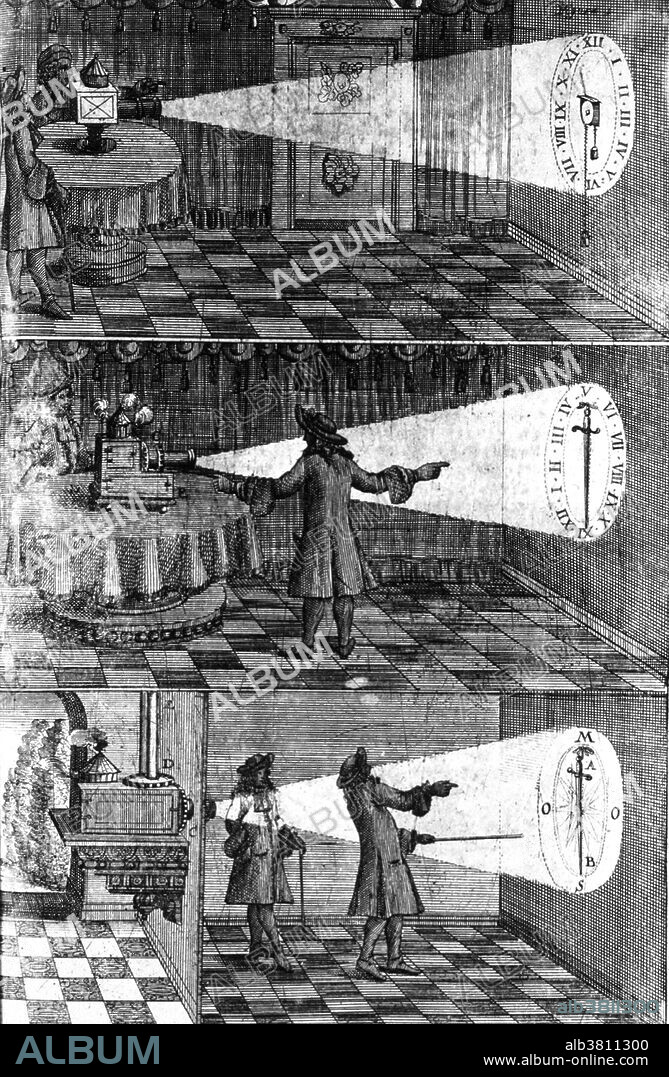alb3811300
Zahn Light Projection Apparatus, 1685

|
Ajouter à une autre Lightbox |
|
Ajouter à une autre Lightbox |



Avez-vous déjà un compte? S'identifier
Vous n'avez pas de compte ? S'inscrire
Acheter cette image.
Sélectionnez l'usage:

Titre:
Zahn Light Projection Apparatus, 1685
Légende:
Traduction automatique: Trois vignettes démontrant un appareil de projection de lumière. Johann Zahn (29 mars 1641 - 27 juin 1707) était un moine allemand et auteur de Oculus Artificialis Teledioptricus Sive Telescopium (1685) qui contient des descriptions, des diagrammes, des illustrations et des croquis de la chambre obscura et de la lanterne magique, ainsi que divers autres lanternes, diapositives, types de projection, boîtes de peepshow, microscopes, télescopes, réflecteurs et lentilles. Le premier appareil photo suffisamment petit et portable pour être pratique pour la photographie a été imaginé par Zahn en 1685, mais il faudra près de 150 ans avant que la technologie ne rattrape son retard. Dans Oculus Artificialis, sa description complète de la lanterne magique (ainsi que douze autres lanternes différentes) inclut certaines de ces lanternes montrant pour la première fois des cache-objectifs. Il s'agissait d'une évolution importante dans l'histoire de l'appareil photo, car cela signifiait que l'écran pouvait rester sombre pendant que l'opérateur changeait la diapositive. Il a également illustré une grande camera obscura d'atelier pour les observations solaires à l'aide du télescope et de la boule scioptrique. Il a également conçu plusieurs caméras obscuras portables et démontré l'utilisation de miroirs et d'objectifs pour ériger l'image, l'agrandir et la focaliser.
Three vignettes demonstrating light projection apparatus. Johann Zahn (March 29, 1641 - June 27, 1707) was a German monk and author of Oculus Artificialis Teledioptricus Sive Telescopium (1685) which contains descriptions, diagrams, illustrations and sketches of both the camera obscura and magic lantern, along with various other lanterns, slides, projection types, peepshow boxes, microscopes, telescopes, reflectors, and lenses. The first camera that was small and portable enough to be practical for photography was envisioned by Zahn in 1685, but it would be almost 150 years before technology caught up to where this was possible to build. In Oculus Artificialis, his comprehensive description of the magic lantern (along with twelve other different lanterns) includes some of these lanterns showing for the first time lens covers. This was an important evolution in the history of the camera, because it meant that the screen could be kept dark while the operator changed the slide. He also illustrated a large workshop camera obscura for solar observations using the telescope and scioptric ball. He also designed several portable camera obscuras, and demonstrated the use of mirrors and lenses to erect the image, enlarge and focus it.
Crédit:
Album / NLM/Science Source
Autorisations:
Taille de l'image:
3300 x 5053 px | 47.7 MB
Taille d'impression:
27.9 x 42.8 cm | 11.0 x 16.8 in (300 dpi)
Mots clés:
ART, PHOTOGRAPHIE • CAMERA OBSCURA • CAMERA • CÉLÈBRE • CELEBRITE • CHAMBRE NOIRE • DIAGRAMME • HOMME • ILLUSTRATION • INSTANTANE (PHOTO) • INSTANTANÉ • LANTERNE MAGIQUE • PHOTOGRAPHIE • SNAPSHOT • TECHNOLOGIE • VIGNETTE
 Pinterest
Pinterest Twitter
Twitter Facebook
Facebook Copier le lien
Copier le lien Email
Email
